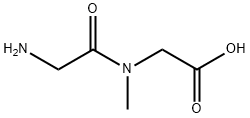GLYCYL-L-PROLINE
- CAS NO.:704-15-4
- Empirical Formula: C7H12N2O3
- Molecular Weight: 172.18
- MDL number: MFCD00020840
- EINECS: 211-880-2
- SAFETY DATA SHEET (SDS)
- Update Date: 2024-11-20 11:41:24

What is GLYCYL-L-PROLINE?
Chemical properties
Crystalline
The Uses of GLYCYL-L-PROLINE
N-Glycylproline was found to exhibit anti-ischemic effects on the metabolism of neuroactive amino acids and indices of energy turnover in the neocortex of rats after experimental brain ischemia.
The Uses of GLYCYL-L-PROLINE
Substrate for Prolidase.
What are the applications of Application
Gly-Pro is a chemical found to exhibit anti-ischemic effects on the metabolism of neuroactive amino acids
Definition
ChEBI: A dipeptide consisting of L-proline having a glycyl residue attached to its alpha-amino group.
Purification Methods
Crystallise glycyl-L-proline from water at 50-60o by addition of EtOH. [Saidel J Am Chem Soc 77 3893 1955, Bergmann et al. Z Physiol Chem 212 79 1932, Beilstein 22 IV 49.]
Properties of GLYCYL-L-PROLINE
| Melting point: | 185℃ |
| Boiling point: | 411.3±40.0 °C(Predicted) |
| Density | 1.356±0.06 g/cm3(Predicted) |
| refractive index | -114 ° (C=4, H2O) |
| storage temp. | Keep in dark place,Inert atmosphere,Store in freezer, under -20°C |
| solubility | Water (Slightly) |
| form | Solid |
| pka | 3.18±0.20(Predicted) |
| color | White to Off-White |
| Water Solubility | very faint turbidity |
| CAS DataBase Reference | 704-15-4(CAS DataBase Reference) |
Safety information for GLYCYL-L-PROLINE
| Signal word | Warning |
| Pictogram(s) |
 Exclamation Mark Irritant GHS07 |
| GHS Hazard Statements |
H319:Serious eye damage/eye irritation |
| Precautionary Statement Codes |
P305+P351+P338:IF IN EYES: Rinse cautiously with water for several minutes. Remove contact lenses, if present and easy to do. Continuerinsing. |
Computed Descriptors for GLYCYL-L-PROLINE
| InChIKey | KZNQNBZMBZJQJO-YFKPBYRVSA-N |
New Products
(S)-3-Aminobutanenitrile hydrochloride 4-Methylphenylacetic acid N-Boc-D-alaninol N-BOC-D/L-ALANINOL Tert-butyl bis(2-chloroethyl)carbamate 3-Morpholino-1-(4-nitrophenyl)-5,6-dihydropyridin- 2(1H)-one Furan-2,5-Dicarboxylic Acid Tropic acid 1-Bromo-3,5-Di-Tert-Butylbenzene S-2-CHLORO PROPIONIC ACID ETHYL ISOCYANOACETATE 2-Bromo-1,3-Bis(Dimethylamino)Trimethinium Hexafluorophosphate 4-IODO BENZOIC ACID 3-NITRO-2-METHYL ANILINE 1-(2,4-DICHLOROPHENYL) ETHANAMINE (2-Hydroxyphenyl)acetonitrile 4-Bromopyrazole 2-(Cyanocyclohexyl)acetic acid 4-methoxy-3,5-dinitropyridine 1-(4-(aminomethyl)benzyl)urea hydrochloride 2-aminopropyl benzoate hydrochloride diethyl 2-(2-((tertbutoxycarbonyl)amino) ethyl)malonate tert-butyl 4- (ureidomethyl)benzylcarbamate Ethyl-2-chloro((4-methoxyphenyl)hydrazono)acetateRelated products of tetrahydrofuran








You may like
-
 Glycyl-L-proline CAS 704-15-4View Details
Glycyl-L-proline CAS 704-15-4View Details
704-15-4 -
 Glycyl-L-proline 95.00% CAS 704-15-4View Details
Glycyl-L-proline 95.00% CAS 704-15-4View Details
704-15-4 -
 Glycyl-l-proline 97% CAS 704-15-4View Details
Glycyl-l-proline 97% CAS 704-15-4View Details
704-15-4 -
 Gly-Pro CAS 704-15-4View Details
Gly-Pro CAS 704-15-4View Details
704-15-4 -
 1975-50-4 98%View Details
1975-50-4 98%View Details
1975-50-4 -
 2-HYDROXY BENZYL ALCOHOL 98%View Details
2-HYDROXY BENZYL ALCOHOL 98%View Details
90-01-7 -
 14714-50-2 (2-Hydroxyphenyl)acetonitrile 98+View Details
14714-50-2 (2-Hydroxyphenyl)acetonitrile 98+View Details
14714-50-2 -
 118753-70-1 98+View Details
118753-70-1 98+View Details
118753-70-1
Statement: All products displayed on this website are only used for non medical purposes such as industrial applications or scientific research, and cannot be used for clinical diagnosis or treatment of humans or animals. They are not medicinal or edible.